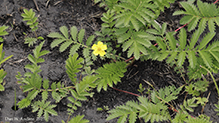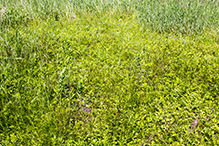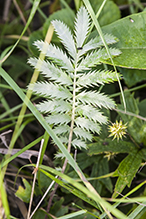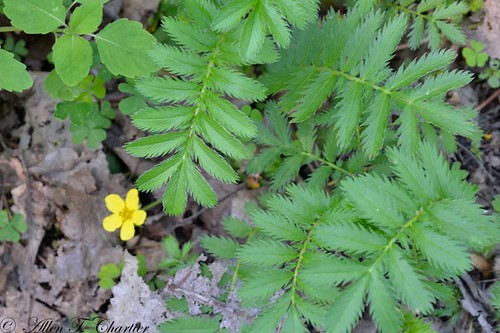silverweed
(Argentina anserina ssp. anserina)
Conservation • Wetland • Description • Habitat • Ecology • Use • Distribution • Taxonomy
Description |
Silverweed is a 2″ to 8″ tall, ascending to erect, perennial forb that rises on basal leaves from a narrow, often branched taproot. It first appears as a dense cluster (rosette) of basal leaves. Soon it produces one or more above-ground, creeping, widely spreading runners (stolons). Basal leaves are inversely lance-shaped in outline (widest toward the tip), up to 10″ long, and up to 4″ wide, rarely longer and usually much smaller. They are on 1″ to 10″ long leaf stalks. Each leaf is pinnately divided into 5 to 31 primary leaflets which often alternate with much smaller secondary leaflets. The leaf axis (rachis) is light green and covered with long, soft, shaggy, sometimes spreading hairs. The leaflets are oblong or inversely egg-shaped. The larger leaflets are up to 2″ long and ¾″ wide, sometimes larger. The lower leaflets are much smaller. The upper surface is green and may be hairless or covered with long, silky, somewhat appressed hairs. The lower surface is white. It is densely covered with short, white, matted or tangled hairs, and moderately to densely covered with long silky hairs. The margins are deeply toothed with sharp, forward pointing teeth. There are usually 5 to 8, but as many as 11 or more teeth per side. The stolons are 12″ to 36″ long with leafy nodes every 4″ to 6″ long. Node leaves are similar to basal leave but smaller. Stolons are red and are covered with long, soft, shaggy, sometimes spreading hairs. They send down roots from the nodes which often creates new plants. The inflorescence is a single flower rising from a stolon node on an ascending to erect, hairy, 2″ to 6″ long stalk (pedicel). The flowers are ⅜″ to ¾″ in diameter. There are 5 modified leaves (epicalyx bractlets), 5 sepals, 5 petals, 20 to 25 stamens, and 20 to 200 or more pistils. The epicalyx bractlets are green, narrowly to broadly egg-shaped to triangular, often toothed, and about the same size as the sepals. They alternate with the sepals and are hidden below the petals when the flower is viewed from above. The sepals are ⅛″ to ⅜″ long and are densely covered with whitish, silky hairs. The petals are yellow, inversely egg-shaped or oval, 3 ⁄16″ to ⅝″ long or longer, and ⅛″ to ⅜″ wide. The petals are longer than the sepals. The stamens have yellow, 1 ⁄16″ to ⅛″ long filaments and yellow anthers. The fruit is a 1 ⁄16″ long seed capsule (achene) with a groove on the upper (dorsal) surface. |
Height |
2″ to 8″ |
Flower Color |
Yellow |
Similar Species |
Silvery cinquefoil (Potentilla argentea) leaves are palmately divided into 5 leaflets. |
Habitat |
Moist to wet. Meadows, marshes, beaches, lakeshores, streambanks, mowed paths. Full sun. Sandy or gravelly soils. |
Ecology |
Flowering |
May to September |
Pests and Diseases |
|
Use |
|
Distribution |
||
|
Sources Biodiversity occurrence data published by: Minnesota Biodiversity Atlas (accessed through the Minnesota Biodiversity Atlas Portal, bellatlas.umn.edu, 6/18/2025). |
|
| 6/18/2025 | ||
Nativity |
||
Native |
||
Occurrence |
||
Common |
||
Taxonomy |
|
Kingdom |
|
| Division |
Tracheophyta (Vascular Plants) |
Subdivision |
Spermatophytina (Seed Plants) |
Class |
|
Order |
Rosales (Roses, Elms, Figs, and Allies) |
Family |
Rosaceae (Rose) |
Subfamily |
Rosoideae (Brambles, Roses, Strawberries, and Allies) |
Tribe |
Potentilleae (strawberries, cinquefoils, and allies) |
Subtribe |
Potentillinae (cinquefoil) |
Genus |
Argentina (silverweeds) |
Species |
Argentina anserina (common silverweed) |
Genus The separation of Argentina remains controversial. USDA PLANTS, GBIF, World Flora Online, and Plants of the World Online recognize the genus; ITIS, GRIN, NCBI, BONAP, and Flora of North America do not. Subspecies |
|
Subordinate Taxa |
|
|
|
Synonyms |
|
Potentilla anserina Potentilla anserina ssp. anserina |
|
Common Names |
|
common silverweed goose-grass goose-tansy silver-weed silverweed silverweed cinquefoil |
|
Glossary
Achene
A dry, one-chambered, single-seeded seed capsule, formed from a single carpel, with the seed attached to the membranous outer layer (wall) only by the seed stalk; the wall, formed entirely from the wall of the superior ovary, does not split open at maturity, but relies on decay or predation to release the contents.
Bract
Modified leaf at the base of a flower stalk, flower cluster, or inflorescence.
Bractlet
A small, often secondary bract within an inflorescence; a bract that is borne on a petiole instead of subtending it; bracteole.
Epicalyx
A whorl of bracts, just below the calyx, resembling a secondary, outer calyx.
Pedicel
On plants: the stalk of a single flower in a cluster of flowers. On insects: the second segment of the antennae. On Hymenoptera and Araneae: the narrow stalk connecting the thorax to the abdomen: the preferred term is petiole.
Pinnate
On a compound leaf, having the leaflets arranged on opposite sides of a common stalk. On a bryophyte, having branches evenly arranged on opposite sides of a stem.
Rachis
The main axis of a compound leaf, appearing as an extension of the leaf stalk; the main axis of an inflorescence.
Rosette
A radiating group or cluster of leaves usually on or close to the ground.
Sepal
An outer floral leaf, usually green but sometimes colored, at the base of a flower.
Stolon
An above-ground, creeping stem that grows along the ground and produces roots and sometimes new plants at its nodes. A runner.
Visitor Photos |
||
Share your photo of this plant. |
||
This button not working for you? |
||
Dan W. Andree |
 |
MinnesotaSeasons.com Photos |
||
 |
 |
|
Habitat |
Plant |
|
 |
 |
|
Plant |
Plant |
|
 |
 |
|
Inflorescence |
Leaf |

Slideshows |
Silverweed |

|
About
Silverweed (Argentina anserina). |
Potentilla anserina (Silverweed) |

|

Visitor Videos |
||
Share your video of this plant. |
||
This button not working for you? |
||
|
Other Videos |
||
Common Silverweed (Argentina Anserina) - 2012-08-29 |
About
Published on Sep 3, 2012 Argentina anserina, also known as Common Silverweed, Silverweed Cinquefoil or just "silverweed", is a flowering perennial plant in the rose family Rosaceae. --------------- |

Visitor Sightings |
||
Report a sighting of this plant. |
||
This button not working for you? |
||
Dan W. Andree |
Location: Twin Valley Prairie SNA |
 |
MinnesotaSeasons.com Sightings |
||

|
Created: 9/24/2015 Last Updated: © MinnesotaSeasons.com. All rights reserved. |
